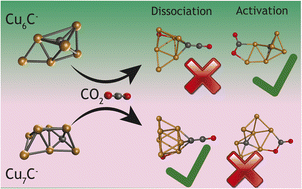Tuning the degree of CO2 activation by carbon doping Cun− (n = 3–10) clusters: an IR spectroscopic study†
Abstract
Copper clusters on carbide surfaces have shown a high catalytic activity towards methanol formation. To understand the interaction between CO2 and the catalytically active sites during this process and the role that carbon atoms could play in this, they are modeled by copper clusters, with carbon atoms incorporated. The formed clusters CunCm− (n = 3–10, m = 1–2) are reacted with CO2 and investigated by IR multiple-photon dissociation (IR-MPD) spectroscopy to probe the degree of CO2 activation. IR spectra for the reaction products [CunC·CO2]−, (n = 6–10), and [CunC2·CO2]−, (n = 3–8) are compared to reference spectra recorded for products formed when reacting the same cluster sizes with CO, and with density functional theory (DFT) calculated spectra. The results reveal a size- and carbon load-dependent activation and dissociation of CO2. The complexes [CunC·CO2]− with n = 6 and 10 show predominantly molecular activation of CO2, while those with n = 7–9 show only dissociative adsorption. The addition of the second carbon to the cluster leads to the exclusive molecular activation of the CO2 on all measured cluster sizes, except for Cu5C2− where CO2 dissociates. Combining these findings with DFT calculations leads us to speculate that at lower carbon-to-metal ratios (CMRs), the C can act as an oxygen anchor facilitating the OC![[double bond, length as m-dash]](https://www.rsc.org/images/entities/char_e001.gif) O bond rupture, whereas at higher CMRs the carbon atoms increasingly attract negative charge, reducing the Cu cluster’s ability to donate electron density to CO2, and consequently its ability to activate CO2.
O bond rupture, whereas at higher CMRs the carbon atoms increasingly attract negative charge, reducing the Cu cluster’s ability to donate electron density to CO2, and consequently its ability to activate CO2.

- This article is part of the themed collection: Nanoalloys: recent developments and future perspectives


 Please wait while we load your content...
Please wait while we load your content...